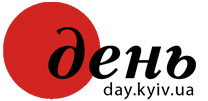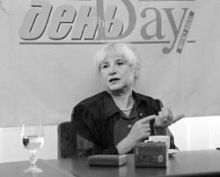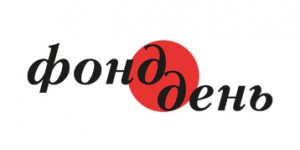POTTERS AND TANNERS. HISTORY LOST FOREVER
The aftermath of a major disaster: and worst of all, a man-made one. That is the only way to describe what the Kyiv architects are doing to the capital. The next place we visited could not be restored. It has been lost forever.
“Take a look at the Honchary and Kozhumyaky [Potters and Tanners]. A graphic example of the violation of all the existing laws. The place is a historic preserve, part of ancient Kyiv,” says Larysa Skoryk. “The status was granted by a Cabinet resolution, then some bureaucrats upstairs decided that this land could be sold and disposed of whichever way they pleased. Ivan Saliy was the first. Back in 1984, as chairman of the Podil district council, he had all structures torn down at the Honchary and Kozhumyaky, all those structures we had been studying at length and depth with Mykhailo Braichevsky, historian and prominent expert on the preservation of monuments. At the time, we, the Society for the Protection of Monuments of the city administration, wanted to keep the place historically authentic, because it was the oldest known settlement of craftsmen in Kyiv, with its parceling – i.e., its planned spacing – handed down by one generation to the next. In the 19th century, this parcel became known as “Kyiv town house.” It was an extremely interesting specimen of Kyiv city architecture. It changed with the times, yet every style was markedly original. In 1984, we decided that 60-80 basic structures would be preserved, all marked and documented. An expedition was dispatched and its findings were forwarded to the Podil rayon council. The documents specified which of the structures had to be preserved and restored and which, if found distressed, were to be rebuilt, using authentic materials, and adapted to modern needs. Well, that was our idea...
“Craftsmen had lived here centuries ago, and craftsmen were actually artists, making beautiful things from leather and potter’s clay. The restoration concept boiled down to having homes associated with the arts, places accommodating Kyiv’s creative community. We planned a small art center on a site that had existed since God knows when. In other words, our project completely preserved the old streets and adjacent parcels of land, patios with gallery-like homes and wings. And the result? It so happened that we all went off on holidays that summer. When we returned a month later we found everything torn down, wiped off the face of the earth. The Podil administration had done a thorough job of it. And then everybody started thinking what next, because the structures torn down were part of selected housing facilities. We again insisted on our project. At the time, Ava Miletsky, architect of Kyivproekt, must have been reluctant or failed to understand what had to be done and how. In the vicinity of the Church of the Exaltation of the Cross they quickly started building something that was a far cry from anything that had been there before. We tried to tell them that it was bad, a profanation. Previously, the place had some magic beauty. The new structures at the Honchary-Kozhumiaky are like advanced syphilitic cases: faceless.
“I must say that I’m somewhat spoiled by refined architecture after Lviv and its conceptual, compositional, flowing perfection. When I moved to Kyiv for quite some time I couldn’t understand why you don’t have the kind of ensembles lending the city a touch of wholesome integrity. Their absence made me sad. But then I spotted the Honchary-Kozhumiaky and the place, dilapidated as it was, reconciled me with Kyiv. I sensed that very ensemble spirit there, the innermost touch of olden times; I saw a very interesting combination of scenic landscape and developments that seemed to flow like a thin stream down the ancient streets. We could still see that beauty with our own eyes, at all angles, because our art academy stands on the mountain right over the ravines. We could take in those charming sights standing on the slope; we saw people return home from work in winter, windows lighting up. It was beautiful! And the hills white with snow, and suede slopes in summer. It was life and the place attracted crowds of intellectuals and aesthetes, because those courtyards were portrayed by Bulgakov and other writers visiting Kyiv.
“After they had destroyed everything, they proceeded to build a new infrastructure, making terribly clumsy retaining walls, driving in common piles. But previously the place had boasted very beautiful buttresses and every courtyard served to reinforce the mountain, preventing landslides with unique engineering constructions of stone or brick. One had to see all that to believe it.
“It was a unique engineering memorial, a place with interesting traditional daily life, an architectural and historic site. Outstanding people lived there, we found plaques with the names of medical dynasties and notes reading “Ring any time, day or night.” It was upper middle class Kyiv. The magnates lived at the Lypky at the time and here was the populace proper with its own aristocratic touch.
People came crying, asking us to help. They didn’t want their homes torn down. They would do anything to have them restored. Although no longer private property, those people and their parents and grandparents had always lived there.
“After completing the new dull infrastructure, the father of the city proceeded to sell plots, even though the law was still to be enacted. They made a smart move, handing plots out to moneyed individuals (we all remember from school that the Communists always wanted to give the land to the poor), in return for which they paid for the infrastructure. And the costs were such no one dared make any improvements. So the place remained an empty lot save for the veterinarian’s house and artist Svetlytsky’s mansion. With time it was overgrown with weeds, creating a jungle of sorts in the center of the city. Later, they started thinking again what to do with the place. When they began the Landscape Alley someone conceived the crazy idea of erecting high-rise buildings up front. Ava Miletsky proposed an institute of archaeology, but shaped like a group of skyscrapers for reasons best known to himself. We succeeded in defeating the project. Then they wanted a park. I was against it, I thought the unique place had to be made part of urban architecture, to keep it alive.
“Now what? When they allowed plots to be sold bargaining started. Who are the new owners? I simply have no time for inquiries, although receiving this information isn’t difficult at all. I have a feeling that before long all propertied residents of Ukraine will live in Kyiv. Kyivproekt came up with a project intended to make the most of this land. If you look at the model you will see a dense carpet-like network of low-rise buildings. A rather modern trend elsewhere in the world, but never in a historical area.
“We have an album with many pictures of the Honchary-Kozhumiaky, illustrating practically every phase in its history. Houses with glass-inlaid galleries, homes varying in shape and design, the architecture reminiscent of that on Andriyivsky Uzviz King Richard’s Castle was a miracle with stairs seemingly made of air and a coach house. An excellent parterre. Precisely the ensemble spirit I found so enchanting about Kyiv. A subtle temperament of intervals and sounds, every building worked into the landscape with loving care.”
LIGHT AND SHADE AND SMELLS OF THE CITY
From the Honchary-Kozhumyaky we went to a place which is perhaps visited by the greatest number of guests to the capital. Getting off the metro at Arsenalna and by foot across Glory Square, the tourists are headed for the Kyiv Pechersk Lavra Monastery.
Larysa Skoryk drew my attention to the square to continue our conversation of unauthorized chopping down. But first was the road.
On our way there, past the Golden Gate, we stopped by the Opera House. Our eyes were attracted by a shining three-floor mansard topping a building behind the Opera, kept in the Rococo style of the Pompadour epoch, with the copper roof and turrets. Ms. Skoryk said that “the Opera looks like a gray mouse against the background of the bright orange facade and gilded bas- reliefs of the building behind.”
“I wish ill to no one,” she continued, “but if someone starts acting with malice toward millions of fellow humans, I become ruthless. I declare war on such individuals. Once there was a small square round the Lysenko statue. People used to come here to sit and rest, and then would climb the beautiful stairs with lampposts on both sides to Lysenko St. Now it is a dead end good only for taking out one’s dog.”
On the way to the Lavra we passed quite a few restored buildings, yet Ms. Skoryk assured me that very few were done by the book.
“There is such a thing as chiaroscuro in architecture [regarding the treatment of light and shade], yet they paint modern houses in a very strange manner. And forget the rules. The Leipzig Hotel is repaired well from a construction engineer’s point of view, but the way it is painted, it looks like a brothel. I give restoration assignments to those of my students who are not very talented in modern quests but with a scholarly meticulous touch. I’m sure they will do no harm that way. Viktor Shkliar, for example, spent a long time in the archives and eventually received the Shevchenko Prize for the restoration of the Mariyinsky Palace.”
Ahead of us was the main square of Ukraine, Maidan Nezalezhnosti, Independence Sq.
“Now this place inspires no comment. That violet tower, a ventilating shaft, takes the cake. A very befitting touch to the new visage of the place. By the way, what does Independence Square smell of?”
“Burned fat from McDonald’s, I guess.”
“Before long that ventilating shaft will exude underground toilet odors. A very comforting prospect, isn’t it?...”
Then we were near the Verkhovna Rada, the only place in Kyiv where one can see the latest models of foreign cars.
WARM GARAGES
Glory Square. Back of the former Young Pioneers Palace the finishing touches are being applied to an underground parking lot. Opposite towers a building with the eloquent notice at the entrance: Kyivmiskbud [Ukrainian abbreviation of Kyiv City Construction Committee]. The wall of the parking lot is crowned by a billboard reading “Warm Garages.”
Previously, you could find a beautiful alley here, then they cleared the place of trees and bushes and built a stone wall, leaving a huge empty space in lieu of ornamental greenery. Felling trees – especially protected species – in a city requires special authorization. You can’t even imagine the kind of red tape it means in the civilized world. There is a special nature protection committee supervising the felling of trees. Suffice to say that chopping down a tree is more expensive than tearing down a building.
“If an organization wants to build something, they can only fall ordinary trees without special authorization – like poplars. But chestnut or lime trees (referred to the protected species) present a very big problem. The developer must make up for all tree-growing expenses and provide as many new trees. Just look over there. A whole grove of protected species vanished into thin air. Who made up for all this? Also, it would be interesting to know what became of the timber.
“I live on the Prospekt Peremohy [Victory Avenue], it’s actually a highway and people should not live close to it. Previously the only thing that kept the pollution level down was the multitude of trees. But then the highway was broadened, the trees were cut down. They promised to plant new ones but never got around to it. Now that the natural barrier against the noise and pollution was no longer there, people started planting trees themselves and did a pretty good job.
“And then they staged a thorough clearing campaign, felling perfectly healthy 25-year-old trees and leaving bad and ailing ones intact. Again, what happened to the timber? Such timber spells very good money. Who profited from all this? But maybe it was just written off. The remaining trees are used to make toy gnomes for children.”
IMMORAL OPPOSITION MORE HARMFUL THAN IMMORAL AUTHORITIES
On the way to the last point on our itinerary, another parking lot construction project on Liuteranska St., Larysa Skoryk spoke of the latest moves made by the opposition.
“I’m a deep oppositionist, but I just can’t bear to watch what’s going on. Deadly enemies siding with each other. I saw the leaflets the Communists printed for the latest elections. Stalin and Zhukov greeting people with Victory Day from the Mausoleum in Moscow. Do you expect me to discuss opposition with Comrade Symonenko? Where is the sense of morality? Talking of morality, why not act under the motto YOU ARE A THIEF? DON’T JOIN THE OPPOSITION! Even an immoral regime can’t do as much harm as an immoral opposition.”
AESTHETIC DISOBEDIENCE CLUB
Liuteranska St. runs steeply down to Khreshchatyk St. There is a grade school at the foot and an underground parking lot is being built a short walk from it, by the house of artist Les Podervyansky. Old stories have it that in winter school students would pour bucketfuls of water down the street and then would help the drivers of skidding cars up the street, in return for a certain reward. What made them start such a project on such a street? Ms. Skoryk recalls how it all began.
“Les would first call me and ask what he should do. They were felling trees before his very eyes. I told him there was nothing to be done, except perhaps murdering those that had initiated the project.”
We were at the house of one of the co-founders of an organization known as the Aesthetic Disobedience Club. We dropped in at Les Podervyansky to ask him about modern Kyiv architecture. Larysa and Les spent some time discussing an organization meant to protect Kyiv from bureaucratic arbitrariness. In the end, Mr. Podervyansky told The Day about what he considered the worst architectural monstrosities.
“Independence Square comes first, of course. There is also a gorgeous house on Lesia Ukrainka Blvd. with a roof shaped like a pile of snot. Oh, I love it! But it’s hard to single out anything especially ugly among all those home-castles in the New Russian style, with all those frills and turrets squeezed into an ordinary condominium. A nightmare! Now we really have lots of things to show the guests of the capital (laughs).”
It was time to leave and we said our good-byes to the future president of the Aesthetic Disobedience Club. By that time Les Podervyansky’s cat was the only living being in the apartment not bothering to guess what the next architectural “masterpiece” in Kyiv would be like.







